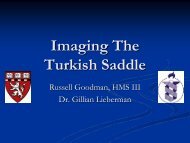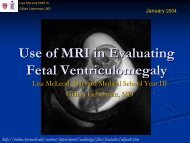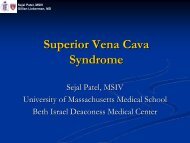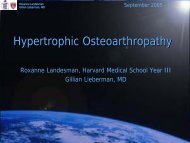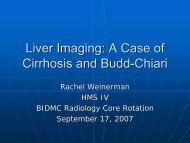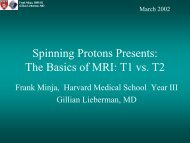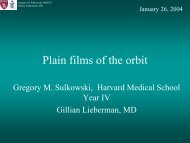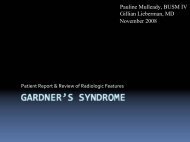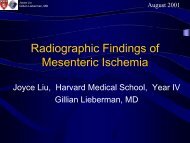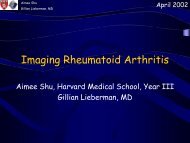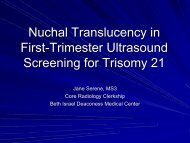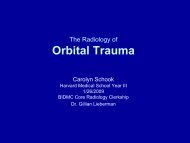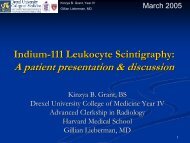Create successful ePaper yourself
Turn your PDF publications into a flip-book with our unique Google optimized e-Paper software.
Melissa Tukey, HMS III<br />
Gillian Lieberman, MD<br />
<strong>Spinal</strong> <strong>Epidural</strong> <strong>Abscess</strong><br />
Melissa Tukey, HMS III<br />
Gillian Lieberman, MD
Melissa Tukey, HMS III<br />
Gillian Lieberman, MD<br />
History of Present Illness<br />
• The patient is a 43-year-old female with a<br />
history of IV drug use who was transferred<br />
to BIDMC with a two day history of<br />
ascending paralysis and sensory loss.<br />
• Neurologic symptoms were preceded by<br />
one week of neck pain that radiated to her<br />
shoulders and migrated down her back.<br />
2
Melissa Tukey, HMS III<br />
Gillian Lieberman, MD<br />
Patient’s History<br />
• PMH: C-section<br />
• Meds: None<br />
• Allergies: Keflex<br />
• SH: Married with three children. 60 pack<br />
year smoking history. Drinks 10-15<br />
alcoholic beverages per week. IV drug<br />
abuse (cocaine last time 10 days prior to<br />
admission).<br />
• FH: CAD<br />
3
Melissa Tukey, HMS III<br />
Gillian Lieberman, MD<br />
Physical Exam<br />
• Vitals: T: 98.6 BP: 112/68 HR: 80 RR: 18 O2: 95%<br />
• Gen: Ill-appearing<br />
• HEENT: MMM<br />
• Neck: no LAD, no bruits, spine not tender to palpation,<br />
significant pain with neck motion.<br />
• CV: RRR, normal S1+S1, no murmurs, rubs or gallops<br />
• Resp: CTAB<br />
• GI: Soft, non-tender, non-distended, + bowel sounds<br />
• GU: 1400 cc residual urine noted at OSH<br />
• Extremities: no clubbing, cyanosis, or edema. Multiple<br />
scars from IV drug use. Strong pulses throughout.<br />
• Rectal: Guaiac negative, decreased rectal tone.<br />
4
Melissa Tukey, HMS III<br />
Gillian Lieberman, MD<br />
Neurologic Exam<br />
• Mental Status: No deficits<br />
• Cranial Nerves: II-XII tested and intact<br />
• Motor (consistent with a lesion around C7/C8):<br />
• Normal bulk throughout<br />
– normal tone in UEs, flaccid tone in LEs<br />
– strength 0/5 in LEs<br />
– Strength 4/5 in deltoids and triceps<br />
– Strength 3/5 in biceps, wrist flexors and extensors<br />
– Strength 0/5 in finger flexors and extensors<br />
• Sensory: Loss of all modalities at approximately C7/C8<br />
• Reflexes: brisk throughout, toes mute with triple flexion bilaterally<br />
Findings highly suspicious for a spinal cord lesion!<br />
5
Melissa Tukey, HMS III<br />
Gillian Lieberman, MD<br />
Labs on Admission<br />
• Chem 7: normal<br />
• WBC: 20 (at OSH)<br />
• ESR: 60<br />
• CRP: 140.8<br />
• Urine toxicology: positive for cocaine<br />
Concerning for infection!<br />
6
Melissa Tukey, HMS III<br />
Gillian Lieberman, MD<br />
Imaging of the <strong>Spinal</strong> Cord<br />
• MRI with intravenous contrast is the modality of choice<br />
for patients with suspected spinal cord lesions.<br />
– Allows visualization of the spinal cord, subarachnoid space, and<br />
surrounding structures.<br />
– Allows differentiation between compressive and non-<br />
compressive etiologies which is critical for patient management.<br />
• CT with intrathecal contrast is an acceptable alternative<br />
if MRI is not available or there are contraindications.<br />
• Plain films are not sensitive for spinal cord lesions<br />
• If neither imaging modality is available the patient should<br />
be transferred to a treatment center where they can be<br />
performed.<br />
(Radiol Clin North Am. 2001 Jan;39(1):115-135)<br />
7
Melissa Tukey, HMS III<br />
Gillian Lieberman, MD<br />
Normal Cervical Spine MRI:<br />
Brainstem<br />
Vertebral Body<br />
Disc<br />
Sagittal<br />
Sagittal T2 weighted image<br />
PACS BIDMC<br />
CSF<br />
<strong>Spinal</strong> Cord<br />
Spinous Process<br />
8
Melissa Tukey, HMS III<br />
Gillian Lieberman, MD<br />
Normal Cervical Spine MRI:<br />
Axial<br />
Vertebral Body<br />
Nerve Root<br />
Vertebral Artery<br />
<strong>Spinal</strong> Cord<br />
CSF<br />
Axial T2 weighted image<br />
PACS BIDMC<br />
9
Melissa Tukey, HMS III<br />
Gillian Lieberman, MD<br />
Patient’s MRI on Admission: T1<br />
Prevertebral area of<br />
hypointensity on T1<br />
weighted image<br />
DDX: Dark on T1<br />
Acute Hematoma<br />
Fluid<br />
Neoplasm<br />
Sagittal T1 weighted image<br />
PACS BIDMC<br />
Distortion of<br />
spinal cord by<br />
material that is<br />
hypointense<br />
on T1<br />
10
Melissa Tukey, HMS III<br />
Gillian Lieberman, MD<br />
Patient’s MRI on Admission: T2<br />
Prevertebral<br />
collection<br />
is hyperintense on T2<br />
DDX: Bright on T2<br />
Chronic Hematoma<br />
Fat<br />
Neoplasm<br />
Fluid<br />
Sagittal T2 Weighted Image<br />
PACS BIDMC<br />
Areas of T2<br />
hyperintensity<br />
surrounding the<br />
spinal cord<br />
11
Melissa Tukey, HMS III<br />
Gillian Lieberman, MD<br />
Patient’s MRI on Admission:<br />
Areas of hyperintensity<br />
are still seen on<br />
STIR images which<br />
have removed signal<br />
from fat.<br />
STIR<br />
Sagittal STIR series<br />
PACS BIDMC<br />
12
Melissa Tukey, HMS III<br />
Gillian Lieberman, MD<br />
Patient’s MRI on Admission:<br />
Diffuse contrast<br />
enhancement of<br />
the prevertebral<br />
soft tissues with a<br />
central area of<br />
non-enhancement<br />
T1 with Contrast<br />
Sagittal T1 with gadolinium contrast enhancement<br />
PACS BIDMC<br />
Peripheral<br />
enhancement of<br />
multiple areas<br />
within the cervical<br />
and thoracic<br />
epidural space.<br />
13
Melissa Tukey, HMS III<br />
Gillian Lieberman, MD<br />
DDX: Extradural Lesions on MRI<br />
• Disk Herniation*<br />
• Tumors (primary and metastatic)*<br />
– Tumors causing compression are most commonly<br />
extensions of vertebral metastases<br />
• Fracture fragment or dislocation from trauma*<br />
• <strong>Epidural</strong> Hematoma*<br />
• <strong>Epidural</strong> <strong>Abscess</strong>*<br />
• Lipomatosis (obesity, steroid therapy, Cushings)<br />
• <strong>Spinal</strong> Stenosis/Osteophyte formation<br />
• Arachnoid Cyst<br />
*These lesions are associated with acute/subacute paraplegia<br />
(Reeder & Felson’s Gamuts in Radiology 4th ed)<br />
14
Melissa Tukey, HMS III<br />
Gillian Lieberman, MD<br />
Summary of our Patient’s MRI<br />
Findings<br />
T1: Hypointense T2: Hyperintense STIR: Hyperintense T1 with contrast:<br />
Rim-enhancement<br />
Classic pattern of findings for a spinal epidural abscess!<br />
PACS BIDMC<br />
15
Melissa Tukey, HMS III<br />
Gillian Lieberman, MD<br />
MRI of <strong>Spinal</strong> Infection<br />
• Infectious processes within the spine are characterized<br />
by:<br />
– bone destruction, particularly of the vertebral end-plates<br />
– obliteration of the normal epidural and paraspinal fat and tissue<br />
planes<br />
– narrowing of the disk space<br />
– presence of an inflammatory mass or abscess<br />
• Infected tissues typically have signals consistent with<br />
more “watery” content and are hypointense on T1,<br />
hyperintense on T2, and enhance with contrast.<br />
• Inflammatory masses will either show uniform contrast<br />
enhancement (phlegmon) or peripheral enhancement<br />
(abscess).<br />
(Radiol Clin North Am. 2001 Mar;39(2):203-211)<br />
16
1<br />
2<br />
Melissa Tukey, HMS III<br />
Gillian Lieberman, MD<br />
Patient’s MRI on Admission:<br />
3<br />
T1 with contrast<br />
T1 with Contrast<br />
PACS BIDMC<br />
1<br />
2<br />
3<br />
Anterior <strong>Abscess</strong><br />
<strong>Epidural</strong> <strong>Abscess</strong><br />
wraps around the<br />
spinal cord in the<br />
region of C7/T1<br />
Posterior <strong>Abscess</strong><br />
17
Melissa Tukey, HMS III<br />
Gillian Lieberman, MD<br />
Patient’s MRI on Admission:<br />
Area of T2 hyperintensity<br />
within the thoracic spinal cord<br />
Axial Images<br />
Axial T2 Weighted Image Axial T1 Weighted Image with Contrast<br />
PACS BIDMC<br />
Peripheral enhancement<br />
of epidural abscess<br />
and small spinal cord abscess<br />
18
Melissa Tukey, HMS III<br />
Gillian Lieberman, MD<br />
<strong>Spinal</strong> <strong>Epidural</strong> <strong>Abscess</strong><br />
• Clinical Manifestations<br />
– Fever<br />
– Malaise<br />
– Back Pain<br />
– Radiculopathy/paresis<br />
– Bladder/Bowel dysfunction<br />
– Plegia<br />
– Sepsis/Mental Status Change<br />
(Am Fam Physician. 2002 Apr 1;65(7):1341-6)<br />
19
Melissa Tukey, HMS III<br />
Gillian Lieberman, MD<br />
<strong>Spinal</strong> <strong>Epidural</strong> <strong>Abscess</strong><br />
• Risk Factors<br />
– Immunodeficiency<br />
• AIDS<br />
• Alcoholism<br />
• Chronic Renal Failure<br />
• Diabetes Mellitus<br />
• Malignancy<br />
– Intravenous Drug Use<br />
– <strong>Spinal</strong> procedure or Surgery<br />
– <strong>Spinal</strong> Trauma<br />
(Am Fam Physician. 2002 Apr 1;65(7):1341-6)<br />
20
Melissa Tukey, HMS III<br />
Gillian Lieberman, MD<br />
<strong>Spinal</strong> <strong>Epidural</strong> <strong>Abscess</strong><br />
• Pathogenesis<br />
– Extension of a focal pyogenic infection to the epidural space<br />
• Osteomyelitis<br />
• Decubitus ulcer<br />
• Iatrogenic complication<br />
– Direct hematogenous seeding<br />
• Microbiology<br />
– Staphylococcus aureus accounts for 2/3 of cases but they can<br />
be caused by many other pathogens.<br />
• Diagnosis<br />
– Requires a high degree of clinical suspicion and prompt imaging!<br />
(Am Fam Physician. 2002 Apr 1;65(7):1341-6)<br />
21
Melissa Tukey, HMS III<br />
Gillian Lieberman, MD<br />
<strong>Spinal</strong> <strong>Epidural</strong> <strong>Abscess</strong><br />
• Treatment<br />
– Antibiotics<br />
– Surgical Decompression vs. Percutaneous<br />
Drainage<br />
• Little evidence that either approach is more<br />
successful.<br />
• Prognosis<br />
– Degree of recovery after surgery is related to<br />
the duration of the neurologic deficits.<br />
(J Emerg Med 2004; 26:285)<br />
22
Melissa Tukey, HMS III<br />
Gillian Lieberman, MD<br />
Companion Patient 1:<br />
Percutaneous Aspiration<br />
L3<br />
L4<br />
Sagittal T1 weighted image with contrast<br />
of a different patient with<br />
vertebral osteomyelitis, discitis and<br />
a lumbar epidural abscess<br />
PACS BIDMC<br />
Fluoroscopic guided aspiration of<br />
L3-L4 disc space<br />
23
Melissa Tukey, HMS III<br />
Gillian Lieberman, MD<br />
Patient’s Hospital Course<br />
• Started on broad antibiotic coverage in the<br />
ED<br />
• Taken to the operating room emergently<br />
– Anterior cervical discectomy/fusion (C5-C7)<br />
– Posterior laminectomies at C5-C7 and T1-T5<br />
– Incision and drainage of anterior and posterior<br />
abscess components<br />
24
Melissa Tukey, HMS III<br />
Gillian Lieberman, MD<br />
Patient’s Hospital Course<br />
• POD0:Blood cultures and wound culture<br />
grew staphylococcus aureus and she was<br />
switched to nafcillin.<br />
• POD1-2: Intubated and sedated in SICU.<br />
When weaned from sedation she showed<br />
no improvement in physical exam.<br />
• POD3: Failed trial of extubation<br />
• POD7: Spine imaging repeated<br />
25
Melissa Tukey, HMS III<br />
Gillian Lieberman, MD<br />
Patient’s Post-operative MRI: T2<br />
Extensive edema<br />
within spinal cord<br />
from cervicomedullary<br />
junction extending<br />
below field of image<br />
Sagittal T2 weighted image<br />
PACS BIDMC<br />
26
Melissa Tukey, HMS III<br />
Gillian Lieberman, MD<br />
Patient’s Post-operative MRI: T1<br />
Sagittal T1 weighted images with contrast<br />
PACS BIDMC<br />
Extensive enhancement within the spinal cord extending from the cervicomedullary<br />
junction to the upper thoracic region with focal intrinsic area of low signal consistent<br />
with a spinal cord abscess<br />
27
Melissa Tukey, HMS III<br />
Gillian Lieberman, MD<br />
Patient’s Post-operative MRI:<br />
T1 with Contrast<br />
T1 weighted images with contrast<br />
PACS BIDMC<br />
<strong>Spinal</strong> Cord<br />
<strong>Abscess</strong><br />
28
Melissa Tukey, HMS III<br />
Gillian Lieberman, MD<br />
Patient’s Hospital Course<br />
• POD14: Patient received PEG and<br />
Tracheostomy<br />
• POD18: Transferred to rehab.<br />
• Discharge Diagnoses<br />
– MSSA epidural and intramedullary abscesses<br />
– Paraplegia<br />
29
Melissa Tukey, HMS III<br />
Gillian Lieberman, MD<br />
References<br />
• Reeder MM. Reeder & Felson’s Gamuts in Radiology:<br />
Comprehensive Lists of Roentgen Differential Diagnosis. 4th<br />
Edition. New York: Springer Verlag Publishing. 2003<br />
• Davis, DP, Wold, RM, Patel, RJ, et al. The clinical presentation and<br />
impact of diagnostic delays on emergency department patients with<br />
spinal epidural abscess. J Emerg Med 2004; 26:285.<br />
• Stabler, A, Reiser, M. Imaging of spinal infections.Radiol Clin North<br />
Am. 2001 Jan;39(1):115-135. Review.<br />
• Varma, R, Lander, P, Assaf, A. Imaging of pyogenic infectious<br />
spondylodiskitis. Radiol Clin North Am. 2001 Mar;39(2):203-211.<br />
Review.<br />
• Chao, D, Nanda, A. <strong>Spinal</strong> epidural abscess: a diagnostic challenge.<br />
Am Fam Physician. 2002 Apr 1;65(7):1341-6. Review.<br />
30
Melissa Tukey, HMS III<br />
Gillian Lieberman, MD<br />
Acknowledgements<br />
• Moritz Kircher, MD<br />
• Gillian Lieberman, MD<br />
• Larry Barbaras<br />
• Pamela Lepkowski<br />
31



